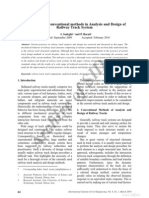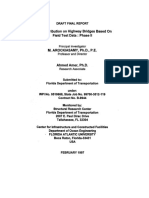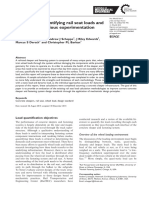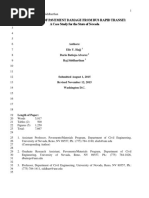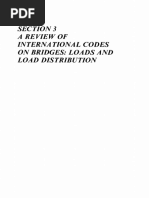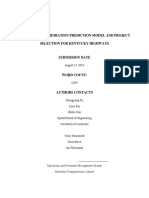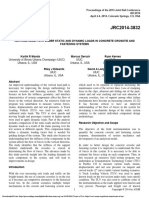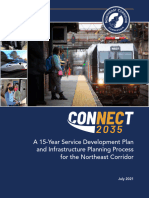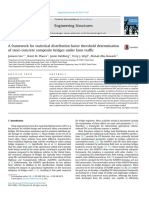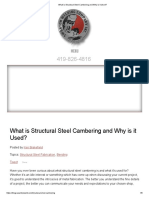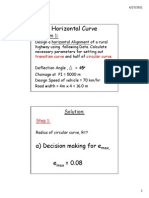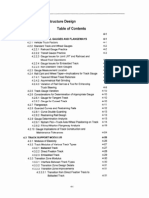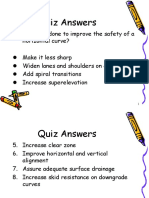DynamicAmplification 2014 TRB 14 4714
DynamicAmplification 2014 TRB 14 4714
Uploaded by
Yousef AlostazCopyright:
Available Formats
DynamicAmplification 2014 TRB 14 4714
DynamicAmplification 2014 TRB 14 4714
Uploaded by
Yousef AlostazOriginal Title
Copyright
Available Formats
Share this document
Did you find this document useful?
Is this content inappropriate?
Copyright:
Available Formats
DynamicAmplification 2014 TRB 14 4714
DynamicAmplification 2014 TRB 14 4714
Uploaded by
Yousef AlostazCopyright:
Available Formats
1 Manuscript for Annual Meeting Compendium of Papers
2
3 Evaluation of Dynamic and Impact Wheel Load Factors and their
4 Application for Design
5
6 TRB 14-4714
7
8 Transportation Research Board 93rd Annual Meeting
10 Submitted: November 15, 2013
11
12
13 Brandon J. Van Dyk1,2, Marcus S. Dersch3, J. Riley Edwards3, Conrad J. Ruppert, Jr.3, and
14 Christopher P. L. Barkan3
15
16 Vossloh Fastening Systems America Corporation2
17 233 South Wacker Drive; Suite 9730
18 Chicago, IL 60606
19
20 Rail Transportation and Engineering Center – RailTEC3
21 Department of Civil and Environmental Engineering
22 University of Illinois at Urbana-Champaign
23 205 N. Mathews Ave., Urbana, IL 61801
24
25 3,248 Words, 10 Tables, 7 Figures = 7,498 Total Word Count
26
Brandon J. Van Dyk1 Marcus S. Dersch J. Riley Edwards
(312) 376-3205 (217) 333-6232 (217) 244-7417
brandon.vandyk
mdersch2@illinois.edu jedward2@illinois.edu
@vossloh-usa.com
Conrad J. Ruppert, Jr. Christopher P.L. Barkan
(217) 300-2132 (217) 244-6338
ruppertc@illinois.edu cbarkan@illinois.edu
27
1
Corresponding author
TRB 2014 Annual Meeting Paper revised from original submittal.
Van Dyk et al. 1
TRB 14-4714
28 ABSTRACT
29 A sustained increase in heavy axle loads and cumulative freight tonnages, coupled with increased
30 development of high speed passenger rail, is placing an increasing demand on railway infrastructure.
31 Some of the most critical areas of the infrastructure in need of further research are track components used
32 in high speed passenger, heavy haul, and shared infrastructure applications. In North America, many
33 design guidelines for these systems use historical wheel loads and design factors that may not necessarily
34 be representative of the loading experienced on rail networks today. Without a clear understanding of the
35 nature of these loads and how design processes reflect them, it is impossible to adequately evaluate the
36 superstructure to make design improvements. Therefore, researchers at the University of Illinois at
37 Urbana-Champaign (UIUC) are conducting research to lay the groundwork for an improved and thorough
38 understanding of the loading environment entering the track structure using wheel loads captured by
39 wheel impact load detectors (WILDs). This paper will identify several design factors that have been
40 developed internationally and evaluate their effectiveness based on wheel loads using several existing and
41 new evaluative metrics. New design factors are also developed to represent the wheel loading
42 environment differently. An evaluative approach to historical and innovative design methodologies will
43 provide improvements to design based on actual loading experienced on today’s rail networks.
TRB 2014 Annual Meeting Paper revised from original submittal.
Van Dyk et al. 2
TRB 14-4714
44 INTRODCTION
45 In North America, many design guidelines for track components in shared-use railway infrastructure use
46 historical wheel loads and several factors. To evaluate the components found in the superstructure and
47 make design improvements, the nature of these loads and how the design process reflects them must be
48 thoroughly understood. There are many parameters that contribute to the actual load imparted into the
49 track structure from the car body. Some of these parameters are considered in design by using a dynamic
50 factor or impact factor for more accurate load estimation. Both of these factors will be defined and
51 evaluated using actual wheel loading data in this paper.
52 There are several types of loads that can be used to design the track structure: static, quasi-static,
53 dynamic, and impact loads. The static load is simply the weight of the rail vehicle at rest. The quasi-
54 static load can be considered the combined static load and the effect of the static load at speed,
55 independent of time (1). The quasi-static load is perhaps best illustrated in curved track, where the
56 vehicle imparts loads onto the rail due to centripetal force and curving (2). The dynamic load is the
57 additional load (above static load) due to high-frequency effects of wheel/rail load interaction,
58 considering time-dependent track component response and involving highly variable inertia, damping,
59 stiffness, and mass. The impact load, which often creates the highest loads in the track structure, is
60 created by track and vehicle irregularities, producing potentially damaging high-frequency, short-duration
61 forces.
62
63 IDENTIFICATION AND EVALUATION OF DYNAMIC WHEEL LOAD FACTORS
64 It is well understood that loads at the wheel-rail interface produced by moving loads are greater than those
65 produced by the same wheel loads at rest (3). Typically, therefore, the design wheel load is higher than
66 the static wheel load to account for this increase due to speed, i.e.,
67 𝑃𝑑 = 𝜙𝑃𝑠
68 where, Pd = dynamic wheel load
69 ϕ = dynamic wheel load factor
70 Ps = static wheel load
71 The dynamic wheel load factor is typically developed empirically using field data and is expressed in
72 terms of train speed. The number of elements considered in its development can depend on the
73 sophistication of the track instrumentation implemented and the assumptions made (4). Historically, there
74 have been many efforts undertaken to quantify the increase of load expected at the wheel-rail interface
75 due to speed.
76
77 Previous Dynamic Factors
78 Doyle (4) provides a summary of many dynamic wheel load factors. Several factors are calculated using
79 only train speed. Beginning in 1943, the Deutsche Bahn (Germany Railways) began using an equation
80 that is only valid for speeds up to 200 kph (125 mph) (5). In 1968, a dynamic factor was prepared for the
81 Washington Metropolitan Area Transit Authority (WMATA) and used in subsequent recommended
82 standards for transit trackwork (6). More recently, another speed-dependent dynamic factor was
83 developed in Iran (7). The final factor dependent only on train speed, although not applied at the wheel-
84 rail interface, is included because of its importance in the design of the track structure. The Speed Factor
85 found in Chapter 30 of the AREMA Manual (8) is used as part of the flexural design of concrete crossties
86 with a distribution factor and impact factor (8). The Chapter 30 Speed Factor, developed in the early
87 1980s by the AREA Committee, is constant below 20 mph (32 kmh) and above 120 mph (193 kmh) (9).
88 Most of the dynamic factors, however, have been developed to incorporate additional parameters
89 beyond train speed. A. N. Talbot provided a factor to the American Railway Engineering Association
90 (AREA) based on tests his committee conducted in the 1910s (10). The Talbot dynamic factor
91 incorporates wheel diameter and is still used in modern North American track analysis (8). The South
92 African Railways formula is similar to the Talbot formula, but is calculated for narrow gauge track. The
TRB 2014 Annual Meeting Paper revised from original submittal.
Van Dyk et al. 3
TRB 14-4714
93 Indian Railways dynamic factor incorporates track modulus as an indicator of track condition (11), while
94 the Clarke Formula algebraically combines the Talbot and Indian Railways dynamic factors (4).
95 Three additional dynamic factors have been developed that incorporate many other parameters.
96 The Eisenmann dynamic factor incorporates the condition of the track and uses a statistical approach
97 where the rail bending stresses and deflections are normally distributed and calculated using
98 Zimmermann’s longitudinal beam model (12). The British Railways dynamic factor is used for discrete
99 irregularities such as a dipped rail joint and was developed in the 1970s using specific track infrastructure,
100 incorporating the vehicle’s unsprung mass, track stiffness at the irregularity, and speed. The most
101 comprehensive dynamic factor was developed by the Office of Research and Experiments (ORE) of the
102 International Union of Railways (UIC), particularly Birmann (13). This factor, valid for speeds up to 200
103 kph (125 mph), incorporates the track geometry, vehicle suspension, vehicle speed, vehicle center of
104 gravity, age of track, curve radius, superelevation, and cant deficiency. Due to the lack of experimental
105 data related to each of these parameters, Doyle (4) makes some reasonable assumptions and simplifies
106 parts of the factor accordingly.
107 A comparison of vehicle and track parameters included in each of the dynamic factors is shown in
108 Tables 1 and 2, while Figure 1 displays the design dynamic factors increasing with speed. Previous
109 research has shown that the rate of load increase due to speed is much higher when wheel quality is poor
110 (14).
TRB 2014 Annual Meeting Paper revised from original submittal.
Van Dyk et al. 4
TRB 14-4714
111 TABLE 1 Summary of Dynamic Factors (adapted from Doyle (1980))
Vehicle Parameters Track Parameters
Included Included
Locomotive Maintenance Condition
Track Maintenance Condition
Track Stiffness at Rail Joint
Cant Deficiency in Curves
Vehicle Center of Gravity
Track Joint Dip Angle
Static Wheel Load
Wheel Diameter
Unsprung Mass
Track Modulus
Curve Radius
Train Speed
Dynamic
Factor Expression for ϕ
Talbot 33𝑉
1+ ● ●
(10) 100𝐷
Indian 𝑉
1+ ● ●
Railways (11) 3√𝑈
Eisenmann
1 + 𝛿𝜂𝑡 ● ●
(12)
ORE/
1+𝛼+𝛽+𝛾 ● ● ● ● ● ●
Birmann (13)
German 11.655𝑉 2 6.252𝑉 3
1+ − ●
Railways (5) 105 107
British 𝐷𝑗 𝑃𝑢
1 + 14.136(𝛼1 + 𝛼2 )𝑉√ ● ● ● ● ●
Railways (4) 𝑔
South African 𝑉
1 + 0.312 ● ●
Railways (4) 𝐷
Clarke 15𝑉
1+ ● ● ●
(4) 𝐷√𝑈
WMATA 2
(1 + 0.0001𝑉 2 )3 ●
(6)
Sadeghi
1.098 + 0.00129𝑉 + 2.59(10−6 )𝑉 2 ●
(7)
AREMA C30 For 20 < 𝑉 < 120: 0.6 + 0.005𝑉 ●
TRB 2014 Annual Meeting Paper revised from original submittal.
Van Dyk et al. 5
TRB 14-4714
112 TABLE 2 Variable Definitions for Table 1
Variable Definition
V Train speed (mph)
D Wheel diameter (in)
U Track modulus (psi)
δ 0.1, 0.2, 0.3, depending on track conditions
η 1 for vehicle speeds up to 37 mph
𝑉−37
1 + 87 for vehicle speeds between 37 and 125 mph
t 0, 1, 2, 3, depending on chosen upper confidence limits defining probability of exceedance
α Coefficient dependent on level of track, vehicle suspension, and vehicle speed, estimated to
𝑉 3
be 0.167 (100) in most unfavorable case
β Coefficient dependent on wheel load shift in curves (0 in tangent track)
γ Coefficient dependent on vehicle speed, track age, possibility of hanging crossties, vehicle
𝑉 3
design, and locomotive maintenance conditions, estimated to be 0.10 + 0.071 (100) in
most unfavorable case
α1 +α2 Total rail joint dip angle (radians)
Dj Track stiffness at the joints (kN/mm)
Pu Unsprung weight at one wheel (kN)
g Acceleration due to gravity (m/s2)
113
TRB 2014 Annual Meeting Paper revised from original submittal.
Van Dyk et al. 6
TRB 14-4714
3.5
Talbot
Indian Railways
Eisenmann
3.0
ORE/Birmann
German Railways
South African Railways
2.5
Clarke
Dynamic Factor, 𝜙
WMATA
Sadeghi
2.0
1.5
1.0
0.5
0.0
0 25 50 75 100 125 150 175 200 225
Speed (mph)
114
115 FIGURE 1 Design dynamic factors increasing due to speed (1 mph = 1.609 kph).
116 Evaluation of Dynamic Factors
117 Many of the dynamic factors discussed in the previous section can only be used to predict the load
118 amplification due to speed in specific operating applications. Because they have been developed over
119 many years in different regions of the world, they may not accurately reflect the operating conditions
120 found in North America. To determine the applicability of these formulas to the North American
121 operating environment, wheel impact load detector (WILD) data was used to compare actual loading data
122 to predicted speed-induced gains. Figure 2 shows an example of locomotive, freight car, and passenger
123 coach wheel load data to be compared with the plotted dynamic factors. To adequately assess the
124 effectiveness of each of the previously developed dynamic factors, several evaluative metrics are
125 considered for each factor (Table 3). The speed-weighted signed difference and load-weighted signed
126 difference were developed to provide a different perspective by weighting train speed and static load
127 respectively.
128 WILD data may underestimate the actual loading conditions because the sites are built with
129 premium components to remove the variation in load due to track geometry and support condition
130 irregularities. However, these data still provide loading information representative of the rail network as
131 a whole and are sufficient for the comparison of dynamic factor effectiveness (14).
TRB 2014 Annual Meeting Paper revised from original submittal.
Van Dyk et al. 7
TRB 14-4714
132
133 FIGURE 2 Peak/nominal wheel load ratios on Amtrak at Edgewood, Maryland
134 (WILD data from November 2010) and design dynamic factors (1 mph = 1.609 kph).
TRB 2014 Annual Meeting Paper revised from original submittal.
Van Dyk et al. 8
TRB 14-4714
135 TABLE 3 Definitions of Dynamic Factor Evaluative Metrics
Percent exceeding – percentage of wheels exceeding predicted dynamic factor
Mean signed difference – summarizes how well an estimator matches the quantity that it is supposed
to estimate
𝑛 xi is the speed of a single wheel
𝑓(𝑥𝑖 ) − 𝑦𝑖 yi is the ratio of peak vertical load to nominal vertical load of a single wheel
∑
𝑛 f(xi) is the predicted dynamic factor of a wheel given its speed
𝑖=1
n is the total number of wheels
Mean percentage error – computed average of percentage errors by which predictions of a model differ
from actual values of the quantity being predicted
𝑛 xi is the speed of a single wheel
100% 𝑓(𝑥𝑖 ) − 𝑦𝑖 yi is the ratio of peak vertical load to nominal vertical load of a single wheel
∑
𝑛 𝑦𝑖 f(xi) is the predicted dynamic factor of a wheel given its speed
𝑖=1
n is the total number of wheels
Root mean square deviation – measures differences between values predicted by estimator and actual
recorded values (absolute value)
xi is the speed of a single wheel
∑𝑛𝑖=1(𝑓(𝑥𝑖 ) − 𝑦𝑖 )2 yi is the ratio of peak vertical load to nominal vertical load of a single wheel
√ f(xi) is the predicted dynamic factor of a wheel given its speed
𝑛
n is the total number of wheels
Speed-weighted signed difference – signed difference, with weight given for the speed of the wheel
xi is the speed of a single wheel
∑𝑛𝑖=1(𝑥𝑖 𝑓(𝑥𝑖 ) − 𝑥𝑖 𝑦𝑖 ) yi is the ratio of peak vertical load to nominal vertical load of a single wheel
∑ 𝑥𝑖 f(xi) is the predicted dynamic factor of a wheel given its speed
n is the total number of wheels
Load-weighted signed difference – signed difference, with weight given for the nominal wheel load
Qi is the nominal load of a single wheel
∑𝑖=1(𝑄𝑖 𝑓(𝑥𝑖 ) − 𝑄𝑖 𝑦𝑖 ) xi is the speed of a single wheel
𝑛
yi is the ratio of peak vertical load to nominal vertical load of a single wheel
∑ 𝑄𝑖 f(xi) is the predicted dynamic factor of a wheel given its speed
n is the total number of wheels
136
137 As shown in Table 1, many of the dynamic factors incorporate other parameters. Therefore,
138 several parameters must be held constant to maintain effective comparisons with respect to speed (Table
139 4). Two factors have been omitted from the analysis. Because the dynamic factor developed for British
140 Railways is appropriate only at rail joint dips, it is not appropriate to evaluate its effectiveness using
141 WILD data. Because the AREMA speed factor is used in combination with an impact factor and is to be
142 applied as an upper bound at the rail seat, it is not necessarily appropriate to be comparing it with other
143 factors that should be used to predict wheel loads.
TRB 2014 Annual Meeting Paper revised from original submittal.
Van Dyk et al. 9
TRB 14-4714
144 TABLE 4 Parameters Held Constant for Dynamic Factor Evaluation (1 in = 25.4 mm,
145 1 psi = 0.006895 MPa)
Parameter Constant Value Justification
Wheel diameter, Typical value for many freight and passenger vehicles in
36 in
D North America
Track modulus, Representative of well-maintained concrete-tie track
6,000 psi
U (as found at WILD site)
Track quality, Representative of track in very good condition
0.1
δ (as found at WILD site)
Confidence factor, Upper confidence limit of 99.7%, applicable for rail stresses,
3
t fastenings, and ties
146
147 The evaluation was performed using data from three WILD sites (Mansfield, Massachusetts;
148 Hook, Pennsylvania; and Edgewood, Maryland) on Amtrak’s Northeast Corridor that experience both
149 higher speed intercity passenger service as well as freight service. After removing the wheels recorded in
150 error (e.g., no nominal load) all remaining wheels that traveled over those sites for one month (November
151 2010) were tabulated and a value for each dynamic factor was calculated based on the speed of the
152 particular wheel and the parameters as found in Table 4. Because some of the dynamic factors have
153 ranges in train speed where they are applicable, those values were calculated using only speeds for which
154 that particular dynamic factor is appropriate. The calculated, or expected, dynamic factor was then
155 compared with the ratio of peak vertical wheel load to nominal wheel load using the metrics found in
156 Table 3. The results of this comparison are shown in Table 5 and, in part, graphically in Figures 3
157 through 5.
TRB 2014 Annual Meeting Paper revised from original submittal.
Van Dyk et al. 10
TRB 14-4714
158 TABLE 5 Evaluation of Dynamic Factors
Dynamic Factors
South African Railways
German Railways
Indian Railways
ORE/Birmann
Eisenmann
WMATA
Sadeghi
Clarke
Talbot
Evaluation Metric
Percent Exceeding 0.23 0.61 0.37 0.75 0.56 0.25 0.45 0.48 0.89
Mean Signed Difference
(𝑓(𝑥𝑖 )−𝑦𝑖 ) 0.20 -0.19 -0.081 -0.25 -0.16 0.16 -0.10 -0.074 -0.31
∑
𝑛
Mean Percentage Error
100% 18 -7.6 0.23 -12 -5.9 16 -1.9 -0.38 -16
∑(𝑓(𝑥𝑖 ) − 𝑦𝑖 )/𝑦𝑖
𝑛
Root Mean Square
Deviation 0.61 0.53 0.51 0.57 0.56 0.59 0.52 0.57 0.57
√∑(𝑓(𝑥𝑖 ) − 𝑦𝑖 )2 /𝑛
Speed-Weighted Signed
Difference 0.37 -0.12 -0.031 -0.18 -0.058 0.38 -0.009 0.079 -0.29
∑(𝑥𝑖 𝑓(𝑥𝑖 ) − 𝑥𝑖 𝑦𝑖 ) / ∑ 𝑥𝑖
Load-Weighted Signed
Difference 0.24 -0.13 -0.018 -0.19 -0.11 0.20 -0.051 -0.027 -0.25
∑(𝑄𝑖 𝑓(𝑥𝑖 ) − 𝑄𝑖 𝑦𝑖 )/ ∑ 𝑄𝑖
159
TRB 2014 Annual Meeting Paper revised from original submittal.
Van Dyk et al. 11
TRB 14-4714
Talbot
Indian Railways
Eisenmann
ORE/Birmann
German Railways
South African Railways
Clarke
WMATA
Sadeghi
-0.4 -0.3 -0.2 -0.1 0 0.1 0.2 0.3 0.4
Mean Signed Difference
160
161 FIGURE 3 Mean signed difference between predicted dynamic factor and
162 peak/nominal ratio.
Talbot
Indian Railways
Eisenmann
ORE/Birmann
German Railways
South African Railways
Clarke
WMATA
Sadeghi
-0.4 -0.3 -0.2 -0.1 0 0.1 0.2 0.3 0.4
Speed-Weighted Signed Difference
163
164 FIGURE 4 Speed-weighted signed difference between predicted dynamic factor and
165 peak/nominal ratio.
TRB 2014 Annual Meeting Paper revised from original submittal.
Van Dyk et al. 12
TRB 14-4714
Talbot
Indian Railways
Eisenmann
ORE/Birmann
German Railways
South African Railways
Clarke
WMATA
Sadeghi
-0.4 -0.3 -0.2 -0.1 0 0.1 0.2 0.3 0.4
Load-Weighted Signed Difference
166
167 FIGURE 5 Load-weighted signed difference between predicted dynamic factor and
168 peak/nominal ratio.
169 As is shown in the preceding figures, there are significant differences between many of the
170 dynamic factors. Positive signed differences, positive mean percentage error, and a low percentage
171 exceedance indicate that the Talbot and South African Railways dynamic factors are fairly conservative
172 when compared to actual loading data. The WMATA speed factor can also be considered conservative
173 by the speed-weighted signed difference metric (likely due to the magnitude of this factor at high speeds,
174 as shown in Figure 1). The other dynamic factors are not overly conservative by any of the metrics, but
175 this does not indicate that they are necessarily poor dynamic factors.
176 To better estimate the effect of speed, a linear estimate of wheel load data was developed using
177 WILD data. To isolate the effect of speed, locomotive wheel loads are initially examined for this
178 analysis. In the author’s opinion, these wheels are more likely to be more consistently maintained and
179 impart fairly reliable static loads. Therefore, the effect of wheel condition and nominal load can be
180 minimized. The change in dynamic factor due to speed can be expressed as following and is illustrated in
181 Figure 6:
𝑃𝑒𝑎𝑘
182 = 1.099 + 0.00386(𝑆𝑝𝑒𝑒𝑑(𝑚𝑝ℎ))
𝑁𝑜𝑚𝑖𝑛𝑎𝑙
TRB 2014 Annual Meeting Paper revised from original submittal.
Van Dyk et al. 13
TRB 14-4714
183
184 FIGURE 6 Linear estimate for dynamic factor on UPRR at Gothenburg, Nebraska
185 (locomotive WILD data from January 2010) (1 mph = 1.609 kph).
186 While many of the wheel loads do exceed the predicted dynamic factor, it is likely not because of
187 speed. There are other factors that affect the magnitude of wheel load beyond speed (14). These factors
188 can more appropriately be incorporated into an impact factor.
189
190 DEFINITION AND EVALUATION OF IMPACT FACTOR
191 As shown in Figure 2, many wheels create loads much higher than those expected due to speed. Because
192 the dynamic factor does not adequately represent actual loading conditions in terms of impact loads, an
193 additional factor should be utilized. The impact factor is used extensively in bridge design and has been a
194 part of concrete crosstie design since the inception of AREA’s design recommendations (9).
195 The AREMA Manual defines the impact factor as a percentage increase over static vertical loads
196 intended to estimate the dynamic effect of wheel and rail irregularities (8). An impact factor of 50% was
197 first used, and has incrementally increased to today’s 200% level (9). A 200% increase above static load
198 indicates that the design load is three times the static load, hereafter referred to as an impact factor of
199 three. Because the impact factor described in this portion of the recommended practices is specifically
200 related to the flexural performance of the crosstie, it may not be representative of the loads experienced at
201 the wheel-rail interface. Therefore, additional impact factors that may better represent wheel loading
202 conditions shall be explored.
203 WILD data is again used to evaluate the effectiveness of the AREMA Chapter 30 impact factor
204 (8) and other theoretical impact factors. Figure 7 shows actual wheel loading at UPRR’s Gothenburg,
205 Nebraska WILD site compared to predicted loads based on various impact factors. These data include
TRB 2014 Annual Meeting Paper revised from original submittal.
Van Dyk et al. 14
TRB 14-4714
206 locomotive, intermodal freight car, non-intermodal loaded freight car, and non-intermodal unloaded
207 freight car wheel loads. For the purpose of this figure, “unloaded freight cars” include any non-
208 intermodal freight car whose nominal wheel load is less than 15 kips. Other freight WILD sites yielded
209 similar results, while passenger coach wheels on Amtrak’s network exceeded the design impact factors
210 more frequently.
211
212 FIGURE 7 Relationship between peak and nominal wheel loads on UPRR at Gothenburg,
213 Nebraska (WILD data from January 2010) and design impact factors (1 kip = 4.45 kN).
214 As shown in Figure 7, the impact factor of three as found in AREMA Chapter 30 exceeds the
215 majority of the locomotive and loaded freight car loads. Because lighter rolling stock (i.e. passenger
216 coaches and unloaded freight cars) have lower static loads, a higher impact factor can be attained with
217 peak loads similar to those seen with other equipment. Therefore, for these types of vehicles, either a
218 greater impact factor or a different design tool that more effectively represents the full loading spectrum
219 may need to be used.
220
221 ALTERNATIVE DESIGN PARAMETER: PEAK TONNAGE
222 While dynamic and impact factors have been used for design for close to a century, it is clearly difficult to
223 design based on solely these factors. There is too much variability to be able to cover entire rail networks
224 or even one line with a simple factor. It is, therefore, worthwhile to pursue alternative design parameters
225 to supplement the factors already in use.
226 Infrastructure owners are typically well aware of the tonnage that traverses each segment of their
227 network. However, this value is calculated by summing the static load of each vehicle, which is not
TRB 2014 Annual Meeting Paper revised from original submittal.
Van Dyk et al. 15
TRB 14-4714
228 always the best estimate for the actual load entering the track structure (14). Therefore, tonnage that is
229 typically reported, or the “static tonnage” may not necessarily represent true field conditions. By
230 accumulating the peak load of each wheel that passes a WILD site, the “peak tonnage” of a line can be
231 calculated.
232 Tables 6 and 7 represent totals at Union Pacific’s Gothenburg, Nebraska WILD site. The trends
233 are fairly consistent between years, as shown by the peak-to-nominal wheel load difference per wheel.
234 Table 8 shows similar information at UPRR’s Sunset, California WILD site, which sees more intermodal
235 traffic.
236 TABLE 6 Tonnage Totals on UPRR at Gothenburg, Nebraska (WILD data from 2010)
237 (1 ton = 0.907185 tonnes)
Number of Nominal Peak Tonnage Difference Difference per
Car Type Wheels Tonnage (tons) (tons) (tons) Wheel (tons)
Locomotives 965,718 16,291,645 20,293,696 4,002,051 4.14
Intermodal
3,001,656 28,778,161 38,562,442 9,784,281 3.26
Freight Cars
Other
20,204,202 144,556,403 197,330,434 52,774,031 2.61
Freight Cars
Total 24,171,576 189,626,209 256,186,572 66,560,363 2.75
238 TABLE 7 Tonnage Totals on UPRR at Gothenburg, Nebraska (WILD data from 2011)
239 (1 ton = 0.907185 tonnes)
Number of Nominal Peak Tonnage Difference Difference per
Car Type Wheels Tonnage (tons) (tons) (tons) Wheel (tons)
Locomotives 959,858 16,237,983 20,170,318 3,932,335 4.09
Intermodal
2,651,116 25,353,219 33,885,533 8,532,314 3.22
Freight Cars
Other
20,571,408 140,831,724 194,917,926 54,086,202 2.63
Freight Cars
Total 24,182,382 182,422,926 248,973,777 66,550,851 2.75
240 TABLE 8 Tonnage Totals on UPRR at Sunset, California (WILD data from 2011)
241 (1 ton = 0.907185 tonnes)
Number of Nominal Peak Tonnage Difference Difference per
Car Type Wheels Tonnage (tons) (tons) (tons) Wheel (tons)
Locomotives 165,896 2,793,015 3,437,503 644,488 3.88
Intermodal
749,760 6,133,002 9,017,303 2,884,301 3.85
Freight Cars
Other
1,001,596 9,785,716 14,065,909 4,280,193 4.27
Freight Cars
Total 1,917,252 18,711,733 26,520,715 7,808,982 4.07
242
243 Similar measures can be tabulated on mixed-use lines utilizing data from Amtrak’s Northeast
244 Corridor (Tables 9 and 10). Because the traffic composition and maintenance of rolling stock differs
245 greatly along the corridor, the measurements vary fairly significantly between sites.
TRB 2014 Annual Meeting Paper revised from original submittal.
Van Dyk et al. 16
TRB 14-4714
246 TABLE 9 Tonnage Totals on Amtrak at Hook, Pennsylvania (WILD data from 2011)
247 (1 ton = 0.907185 tonnes)
Number of Nominal Peak Tonnage Difference Difference per
Car Type Wheels Tonnage (tons) (tons) (tons) Wheel (tons)
Passenger
234,950 2,986,719 3,922,364 935,645 3.98
Locomotives
Freight
11,523 186,060 209,773 23,713 2.06
Locomotives
Passenger
1,529,770 26,040,498 35,181,894 9,141,396 5.98
Coaches
Intermodal
12,135 119,534 138,446 18,912 1.56
Freight Cars
Other
77,746 778,616 938,637 160,021 2.06
Freight Cars
Total 1,866,124 30,111,427 40,391,114 10,279,687 5.51
248 TABLE 10 Tonnage Totals on Amtrak at Mansfield, Massachusetts (WILD data from 2011)
249 (1 ton = 0.907185 tonnes)
Number of Nominal Peak Tonnage Difference Difference per
Car Type Wheels Tonnage (tons) (tons) (tons) Wheel (tons)
Passenger
161,161 2,346,728 3,394,357 1,047,629 6.50
Locomotives
Freight
14,304 249,835 303,458 53,623 3.75
Locomotives
Passenger
831,735 11,856,667 21,325,896 9,469,229 11.38
Coaches
Intermodal
4,276 34,771 53,171 18,400 4.30
Freight Cars
Other
139,953 1,308,788 1,865,539 556,751 3.98
Freight Cars
Total 1,151,429 15,796,789 26,942,421 11,145,632 9.68
250
251 Design processes that involve tonnage may be able to take advantage of existing peak tonnage
252 values and apply them to other segments with similar traffic composition. Those that are more axle-load-
253 oriented may be able to use the appropriate “difference per wheel” value in addition to the expected static
254 loads on a particular line. This measurement helps to provide an accurate increase of load, but it does not
255 address the particular reasons for increase.
256 It should be noted that the peak tonnage measurement is not a completely accurate representation
257 of actual tonnage either. Because the values are attained using “peak” loads over a discrete length of
258 track (16 crosstie cribs (15)), the majority of the track structure may not experience loads at such a high
259 magnitude. However, the quantities are also measured at well-maintained WILD sites, eliminating any
260 track-related increase in loads. Therefore, the peak tonnage may provide an adequate estimation of actual
261 tonnage.
262
263 CONCLUSIONS
264 There have been many efforts to quantify the effect of speed and irregularities in the form of dynamic and
265 impact factors, respectively. As shown in this paper, some represent today’s loading environment in
TRB 2014 Annual Meeting Paper revised from original submittal.
Van Dyk et al. 17
TRB 14-4714
266 North America better than others. Depending on the metric used to evaluate each factor, the factors vary
267 in their conservatism. The appropriate level of design should be selected by the infrastructure owner, and
268 more than one factor may be necessary in determining the design wheel load for the track infrastructure.
269 Higher-degree estimates and dynamic factors that include other parameters may be developed and
270 evaluated in the future to better represent the dynamic wheel loading environment. Rigorous statistical
271 methods may be used to effectively model the effect of speed and many other factors.
272 An additional design parameter methodology has been proposed, providing additional
273 information that was not necessarily evident with the dynamic and impact factors. Multiple factors may
274 be needed to adequately represent the existing wheel loads on the North American rail network and
275 improve design of the critical components that make up the track structure.
276
277 ACKNOWLEDGEMENTS
278 Funding for this research has been provided by the United States Department of Transportation (US
279 DOT) Federal Railroad Administration (FRA). The published material in this paper represents the
280 position of the authors and not necessarily that of DOT. Industry partnership and support has been
281 provided by Union Pacific Railroad; BNSF Railway; Amtrak; Amsted RPS; GIC Ingeniería y
282 Construcción; Hanson Professional Services; and CXT Concrete Ties. For providing direction, advice,
283 and resources, the authors would like to thank Mike Tomas from Amtrak, William GeMeiner from Union
284 Pacific Railroad, and Winfried Boesterling from Vossloh. Additionally, the authors thank the members of
285 AREMA Committee 30, Subcommittee 4 (Concrete Crosstie Technology) for their continued support and
286 guidance in UIUC’s concrete crosstie research. The authors’ gratitude is also expressed to Anna
287 Delheimer, Andrew Scheppe, and Andrew Stirk from UIUC, who have provided invaluable service in
288 data processing, formatting, and analyzing. The authors would also like to thank Bassem Andrawes,
289 Thiago Bizarria do Carmo, Zhe Chen, Justin Grassé, Matthew Greve, Ryan Kernes, Daniel Kuchma,
290 David Lange, Kartik Manda, Christopher Rapp, Moochul Shin, Amogh Shurpali, Brent Williams, and
291 Sihang Wei from UIUC for their involvement in this research effort. J. Riley Edwards has been
292 supported in part by grants to the UIUC RailTEC from CN, CSX, Hanson Professional Services, Norfolk
293 Southern, and the George Krambles Transportation Scholarship Fund.
TRB 2014 Annual Meeting Paper revised from original submittal.
Van Dyk et al. 18
TRB 14-4714
294 REFERENCES
295 (1) Australian Standard. Standards Australia International. s.n., 2003.
296 (2) Andersson, E., M. Berg, and S. Stichel. Rail Vehicle Dynamics. KTH, Royal Institute of
297 Technology, Stockholm, Sweden, 2013.
298 (3) Kerr, A. D. Fundamentals of Railway Track Engineering. Simmons-Boardman Books,
299 Incorporated, Omaha, Nebraska, 2003.
300 (4) Doyle, N. F. Railway Track Design: A Review of Current Practice. BHP Melbourne Research
301 Laboratories, Bureau of Transport Economics, 1980.
302 (5) Schramm, G. Permanent Way Technique and Permanent Way Economy. Otto Elsner
303 Verlagsgesellschaft, 1st. Darmstadt, Germany, 1961.
304 (6) Prause, R. H., et al. Assessment of Design Tools and Criteria for Urban Rail Track Structures.
305 Department of Transportation: Urban Mass Transportation Administration, 1974.
306 (7) Sadeghi, J. and P. Barati. Evaluation of conventional methods in Analysis and Design of
307 Railway Track System. In International Journal of Civil Engineering, Vol. 8,2010, p. 46.
308 (8) AREMA Manual for Railway Engineering. American Railway Engineering and Maintenance-of-
309 Way Association. s.n., 2012.
310 (9) McQueen, P. J. Flexural Performance Requirements for Prestressed Concrete Ties by Factoring.
311 San Rafael, California: Philip J. McQueen Corporation, 2010.
312 (10) Hay, W. W. Railroad Engineering. John Wiley & Sons, Inc., New York, 1953.
313 (11) Srinivasan, M. Modern Permanent Way. Somaiya Publications Pvt. Ltd., Mumbai, India, 1969.
314 (12) Esveld, C. Modern Railway Track. MRT Productions, Zaltbommel, the Netherlands, 2001.
315 (13) Birmann, F. Track Parameters, Static and Dynamic. In Proceedings of the Institution of
316 Mechanical Engineers, Conference Proceedings, Vol. 180, Sage Publications, 1965, pp. 77-79.
317 (14) Van Dyk, B. J., et al. Quantifying Shared Corridor Wheel Loading Variation Using Wheel
318 Impact Load Detectors. In Proceedings of the 2013 Joint Rail Conference, s.n., Knoxville,
319 Tennessee: 2013.
320 (15) GeMeiner, W. Workshop 139 - Leveraging of WILD Vertical Force Data at Union Pacific.
321 Proceedings of the 2005 Transportation Research Board Annual Meeting, Washington, D.C.,
322 2005.
TRB 2014 Annual Meeting Paper revised from original submittal.
You might also like
- Unit 42 - Highway Engineering Assignment 1 (Set C)Document9 pagesUnit 42 - Highway Engineering Assignment 1 (Set C)Compliance Course 2020100% (2)
- Wheel Load Contact AreaDocument13 pagesWheel Load Contact AreaGnabBang100% (1)
- Development of Traffic Live Load Models For Bridge SuperstructureDocument52 pagesDevelopment of Traffic Live Load Models For Bridge Superstructurerithy khouyNo ratings yet
- Unit Conversion TableDocument217 pagesUnit Conversion TableNull NullNo ratings yet
- IrfanulHassan MUET Bridge 2009 PDFDocument19 pagesIrfanulHassan MUET Bridge 2009 PDFYasir IqbalNo ratings yet
- IrfanulHassan MUET Bridge 2009Document19 pagesIrfanulHassan MUET Bridge 2009Mirza Waqar BaigNo ratings yet
- Critical Traffic Loading For Prestressed Concrete Design (NLC)Document19 pagesCritical Traffic Loading For Prestressed Concrete Design (NLC)Sana FatimaNo ratings yet
- Railway Transportation Systems: Design, Construction and Operation, 2nd Edition Christos N. Pyrgidis all chapter instant downloadDocument50 pagesRailway Transportation Systems: Design, Construction and Operation, 2nd Edition Christos N. Pyrgidis all chapter instant downloaddaridatamno100% (4)
- Axle Load SpectrumDocument144 pagesAxle Load SpectrumAnurag VermaNo ratings yet
- Serviceability in The Design of Bridge FoundationsDocument11 pagesServiceability in The Design of Bridge FoundationsAnton Husen PurboyoNo ratings yet
- NCHRP w28Document65 pagesNCHRP w28juancarrionmonsalve100% (1)
- Considerations For Mechanistic Design of Concrete Sleepers and Elastic Fastening Systems in North AmericaDocument8 pagesConsiderations For Mechanistic Design of Concrete Sleepers and Elastic Fastening Systems in North AmericaMin Chan MoonNo ratings yet
- Dist Facts For M and VDocument54 pagesDist Facts For M and VBrither FACNo ratings yet
- VanDyk Et Al 2016 JRRT Methods For Quantifying Rail Seat LoadsDocument11 pagesVanDyk Et Al 2016 JRRT Methods For Quantifying Rail Seat LoadsSajid IqbalNo ratings yet
- Principal Components Analysis and Track Quality Index: A Machine Learning ApproachDocument20 pagesPrincipal Components Analysis and Track Quality Index: A Machine Learning ApproachAnisya FriscilyaNo ratings yet
- Assesment of Pavement Damage From Bus Rapid Transit: A Case Study For The State of NevadaDocument18 pagesAssesment of Pavement Damage From Bus Rapid Transit: A Case Study For The State of NevadaHossein DoudiNo ratings yet
- Kamjoo 2018Document10 pagesKamjoo 2018rithy khouyNo ratings yet
- Structural Redundancy of Prestressed Concrete Box Girder BridgesDocument21 pagesStructural Redundancy of Prestressed Concrete Box Girder BridgesAngélica Tatiana Cruz OrozcoNo ratings yet
- Evaluation of The Dynamic Amplification Factor ForDocument12 pagesEvaluation of The Dynamic Amplification Factor ForMücahit AtalanNo ratings yet
- Derailment-Resistant Performance of Modular Composite Rail Track Slabs.Document31 pagesDerailment-Resistant Performance of Modular Composite Rail Track Slabs.Mohamed Ebrahim MohamedNo ratings yet
- Chapter 4 Bridge Loading Review Paper.27787.0003Document106 pagesChapter 4 Bridge Loading Review Paper.27787.0003John FantahunNo ratings yet
- The Effects of Top of Rail Materials On Head Hardened Rail With The Practice of Rail GrindingDocument5 pagesThe Effects of Top of Rail Materials On Head Hardened Rail With The Practice of Rail GrindingSrikanth SrikantiNo ratings yet
- Noaa 51714 DS1Document38 pagesNoaa 51714 DS1Augusto MamedeNo ratings yet
- Lavinia TC3 PaperDocument8 pagesLavinia TC3 PapermehdiNo ratings yet
- Pavement Deterioration Prediction Model and Project Selection For Kentucky HighwaysDocument13 pagesPavement Deterioration Prediction Model and Project Selection For Kentucky HighwaysStacy JohnsonNo ratings yet
- Tunneling Underground: and StructuresDocument51 pagesTunneling Underground: and StructuresDhiraj NaxineNo ratings yet
- Rdso Guide Lines FR BridgesDocument76 pagesRdso Guide Lines FR BridgesUtpal KantNo ratings yet
- Structural - Control - and - Health - Monitoring 2016Document17 pagesStructural - Control - and - Health - Monitoring 2016hima_bindu_89No ratings yet
- Truck Factor PDFDocument91 pagesTruck Factor PDFschavezlozano100% (2)
- Load Model For Bridge Design Code - Canadian Journal of Civil EngineeringDocument15 pagesLoad Model For Bridge Design Code - Canadian Journal of Civil Engineeringg401992100% (1)
- 35 +Effects+of+Cross-Slope+Break+on+Roadway+Departure+Recovery+of+Trucks+on+Horizontal+CurvesDocument19 pages35 +Effects+of+Cross-Slope+Break+on+Roadway+Departure+Recovery+of+Trucks+on+Horizontal+CurvesEsmir ŠkreboNo ratings yet
- Development of Live Load Distribution Factor Equation For Girder BridgesDocument11 pagesDevelopment of Live Load Distribution Factor Equation For Girder BridgesA MumtazNo ratings yet
- Backcalculation of Dynamic Modulus From Falling Weight Deflectometer Data - Final ReportDocument68 pagesBackcalculation of Dynamic Modulus From Falling Weight Deflectometer Data - Final ReportMuluneh WakoNo ratings yet
- Mathematical Traffic Load Modelling andDocument38 pagesMathematical Traffic Load Modelling andKhalilNo ratings yet
- Evaluation of Planning Options To Alleviate Traffic Congestion and Resulting Air Pollution in Dhaka City PDFDocument157 pagesEvaluation of Planning Options To Alleviate Traffic Congestion and Resulting Air Pollution in Dhaka City PDFNeelShwapnoNo ratings yet
- Ge - 14Document75 pagesGe - 14Binod Sharma100% (3)
- Page 58Document212 pagesPage 58Saad Al HelyNo ratings yet
- Objective Track Quality Indices: Magdy El-Sibaie and Yu-Jiang ZhangDocument7 pagesObjective Track Quality Indices: Magdy El-Sibaie and Yu-Jiang ZhangMarina GamaNo ratings yet
- Analysis of Superelevation and Side Friction Factor On Horizontal CurveDocument5 pagesAnalysis of Superelevation and Side Friction Factor On Horizontal CurveFrancisco GranadosNo ratings yet
- Report # MATC-UNL: 227 Final ReportDocument61 pagesReport # MATC-UNL: 227 Final ReportAnusha KishoreNo ratings yet
- IRC Codes For Road bridges-IRS Sec I, II, IIIDocument2 pagesIRC Codes For Road bridges-IRS Sec I, II, IIImp SinghNo ratings yet
- Reference PresentationDocument7 pagesReference Presentation64011110No ratings yet
- 02 Time-Based Track Quality IndexDocument16 pages02 Time-Based Track Quality IndexmuthurajanNo ratings yet
- Truss Bridge ProjectDocument16 pagesTruss Bridge ProjectChrisYap100% (1)
- Comparing The Use of Artificial Neural Networks AnDocument10 pagesComparing The Use of Artificial Neural Networks AnAbhimanyu KumarNo ratings yet
- Connect Nec 2035 PlanDocument274 pagesConnect Nec 2035 Planm.cremades.cpsNo ratings yet
- Load Distribution Factors of Simply Supported Concrete T-Beam Bridges Under Typical Freight Vehicle Loads.Document8 pagesLoad Distribution Factors of Simply Supported Concrete T-Beam Bridges Under Typical Freight Vehicle Loads.MiguelHRNo ratings yet
- Live Loads Farms 2Document11 pagesLive Loads Farms 2albertoxinaNo ratings yet
- Evaluation of Safety and Operational Efficiency Using Structural Health Monitoring EnhancementDocument7 pagesEvaluation of Safety and Operational Efficiency Using Structural Health Monitoring EnhancementHamada Shoukry MohammedNo ratings yet
- Assessment of Locomotive and Multi-Unit Fatigue Strength Considering The Results of Certifi Cation Tests in Ukraine and EU CountriesDocument8 pagesAssessment of Locomotive and Multi-Unit Fatigue Strength Considering The Results of Certifi Cation Tests in Ukraine and EU CountriesLeonardo Antônio Pereira100% (1)
- Looking To Load and Resistance Factor RatingDocument17 pagesLooking To Load and Resistance Factor Ratingsmartman35No ratings yet
- Bridge Element Deterioration Rates PDFDocument105 pagesBridge Element Deterioration Rates PDFnguoi_co_docNo ratings yet
- Review of Falling Weight Deflectometer For Assessment of Flexible PavementDocument18 pagesReview of Falling Weight Deflectometer For Assessment of Flexible PavementSUMIT KUMARNo ratings yet
- Track Modulus 3Document27 pagesTrack Modulus 3Marius DiaconuNo ratings yet
- Design of RC Bridge Columns For Near Fault Earthquakes SeyedCCEERReport13-13Document393 pagesDesign of RC Bridge Columns For Near Fault Earthquakes SeyedCCEERReport13-13TuroyNo ratings yet
- Pavement Management Systems Past Present and FuturDocument27 pagesPavement Management Systems Past Present and FuturMaster GordonNo ratings yet
- Review of Related Literature Brief History of DPWH-BSDSDocument12 pagesReview of Related Literature Brief History of DPWH-BSDSGaiusChrisA.EvaNo ratings yet
- PHodgsonThesisComplete PDFDocument490 pagesPHodgsonThesisComplete PDFBogdan IonitaNo ratings yet
- Evaluation of Dynamic Vehicle Axle Loads On Bridges With Different Surface ConditionsDocument23 pagesEvaluation of Dynamic Vehicle Axle Loads On Bridges With Different Surface ConditionsBridge&StructureNo ratings yet
- CE 517 Project - RiobaDocument12 pagesCE 517 Project - RiobaDuncanNo ratings yet
- Turning the Right Corner: Ensuring Development through a Low-Carbon Transport SectorFrom EverandTurning the Right Corner: Ensuring Development through a Low-Carbon Transport SectorNo ratings yet
- CMU BlastDocument18 pagesCMU BlastYousef AlostazNo ratings yet
- BianchiPaper SitingDocument9 pagesBianchiPaper SitingYousef AlostazNo ratings yet
- WindLoading Temp StructureDocument2 pagesWindLoading Temp StructureYousef AlostazNo ratings yet
- Ballistic Testing AluminDocument32 pagesBallistic Testing AluminYousef AlostazNo ratings yet
- What Is Structural Steel Cambering and Why Is It UsedDocument3 pagesWhat Is Structural Steel Cambering and Why Is It UsedWang ChenNo ratings yet
- UIC 518 2.desbloqueadoDocument78 pagesUIC 518 2.desbloqueadoDustin RodriguezNo ratings yet
- Design of RotaryDocument39 pagesDesign of RotarySunilAjmeeraNo ratings yet
- 2007 BC Supplement To TacDocument510 pages2007 BC Supplement To TacCharlesNo ratings yet
- Nepal Road Standard - 2027-Second RevisionDocument57 pagesNepal Road Standard - 2027-Second RevisionSushil DhunganaNo ratings yet
- 04 - Part A - TrackDocument93 pages04 - Part A - TrackJayanta MondalNo ratings yet
- TCRP Report 57 - Track Design Handbook For Light Rail TransitDocument344 pagesTCRP Report 57 - Track Design Handbook For Light Rail TransitbcleeNo ratings yet
- Realignment of Railway CurvesDocument7 pagesRealignment of Railway CurveshunnyNo ratings yet
- HIGHWAYS, Attainment of SuperelevationDocument39 pagesHIGHWAYS, Attainment of Superelevationabubakar100% (1)
- Igus Terminology: Short Cut Description Application-IconsDocument5 pagesIgus Terminology: Short Cut Description Application-Iconsv2304451No ratings yet
- Session 2a - Horizontal Curves-Superelevation-And Geometric Design StandardsDocument43 pagesSession 2a - Horizontal Curves-Superelevation-And Geometric Design Standardsmannie edetNo ratings yet
- Lo 2018-40 Frs Eng WebDocument57 pagesLo 2018-40 Frs Eng WebSamira ErramiNo ratings yet
- Module 2 Railroad Infrastructure REES 2010 PDFDocument148 pagesModule 2 Railroad Infrastructure REES 2010 PDFHanna TbNo ratings yet
- Horizontal Alignment Design ExampleDocument13 pagesHorizontal Alignment Design ExampleEmily YoungNo ratings yet
- AM I - MicroprojectDocument16 pagesAM I - MicroprojectKavita AldarNo ratings yet
- LRT Track Design-TCRP ReportDocument91 pagesLRT Track Design-TCRP Reportlakshmi1011100% (1)
- Shelter at Railway Stations and Interchanges: StandardDocument25 pagesShelter at Railway Stations and Interchanges: StandardyosNo ratings yet
- Chapter 2Document50 pagesChapter 2Yitbarek BayieseNo ratings yet
- 10035-STR-RPT-0001 - DBR - Straight and Mild Curve R3Document68 pages10035-STR-RPT-0001 - DBR - Straight and Mild Curve R3darshanNo ratings yet
- Uic Comfort Tests Investigation of Ride Comfort and Comfort Disturbance On Transition and Circular CurvesDocument130 pagesUic Comfort Tests Investigation of Ride Comfort and Comfort Disturbance On Transition and Circular CurvescezarNo ratings yet
- Railway UnitDocument131 pagesRailway UnitNurholis100% (1)
- Curves Lecture 5 Kdu Sri LankaDocument43 pagesCurves Lecture 5 Kdu Sri LankaAshenPereraNo ratings yet
- 18 Superelevation and Spiral CurvesDocument54 pages18 Superelevation and Spiral CurvesjamilthaljiNo ratings yet
- PwayQBDocument49 pagesPwayQBHemantSharmaNo ratings yet
- Lesson 1 - Simple CurveDocument66 pagesLesson 1 - Simple CurveFrancis Philippe Cruzana CariñoNo ratings yet
- Odc GuidelineDocument7 pagesOdc GuidelineCDO RourkelaNo ratings yet
- Cross SectionDocument47 pagesCross SectionDevi PrasadNo ratings yet
- SW Road V2: Operation ManualDocument73 pagesSW Road V2: Operation ManualAjay SinghNo ratings yet

